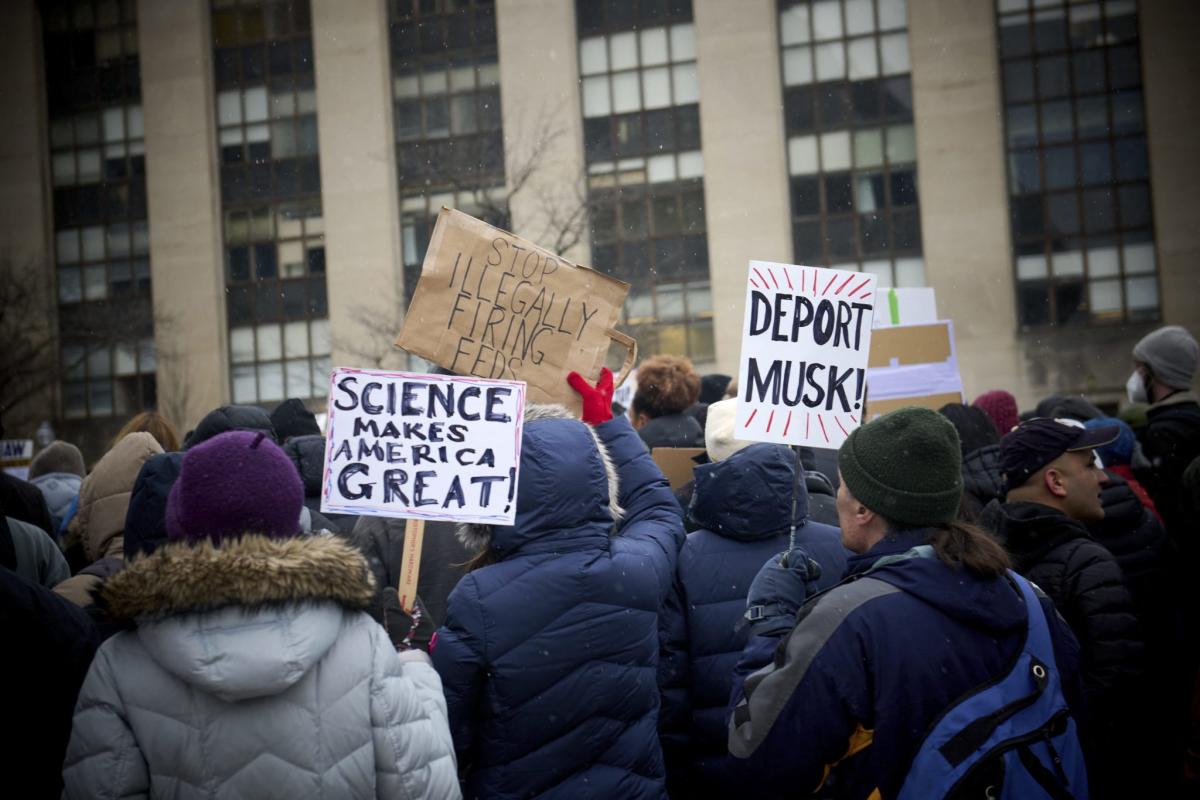
-
The Trump administration’s vow to cut $4 billion in medical research targets so-called indirect funding, which he claims to be wasteful. But these costs are key to allowing medical institutions to exist, with scientists decrying the budget moves as a death blow that could lead top American scientists to jump ship to China and alter the scientific exchange of data.
Recently, the medical research communities saw their livelihoods flash before their eyes as the Trump administration announced the world’s leading benefactor in medical research grants was being put on a diet.
World’s richest man Elon Musk, who initially claimed the Department of Government Efficiency (DOGE) could cut $2 trillion in government spending but has waffled on that figure since then, has been busy trimming federal agency budgets across the country in recent weeks. The National Institute of Health is up next: Last week, it announced DOGE will cut more than $4 billion from the NIH budget—which equates to 11% of its 2023 budget—impacting major research institutions nationwide.
The National Institute of Health is the paramount government agency in the U.S. when it comes to conducting and supporting medical research. In 2023, the NIH yielded more than $35 billion in funding to disease-related research projects.
Advertisement
Advertisement
The budget cuts trimmed facility and administration expenses, known as indirect costs, to 15%. These funds cover overhead costs for institutions, including their electricity bills, equipment, and rent.
“I think it’s the end of science as we know it for the United States if that really goes through,” Richard Huganir, director of the Department of Neuroscience at Johns Hopkins University, told Fortune.
The Trump administration is levying NIH’s indirect funding budget to play on par with private philanthropic organizations. Entities like the John Templeton Foundation and the Rockefeller Foundation carry the highest level of indirect cost coverage of private philanthropic organizations at 15%.
Formerly, the NIH did not have a cap on indirect fund support. On average, indirect costs from the NIH reached 27.5%, and many times allocated administrative overhead up to 50% or 60%.
Advertisement
Advertisement
In an X post, the top receivers from were Harvard, Yale, and Johns Hopkins, who received indirect rates of 69%, 67.5%, and 63.7%, respectively. When asked about the NIH budget cuts, Trump said, “Why are we giving money to Harvard when it’s got a $50 billion endowment, 50 billion and yet they don’t use that endowment to help their students.”
Dwight Bergles, a professor of neuroscience at the Johns Hopkins University School of Medicine, refutes the notion that the NIH should be on the same playing field as private philanthropic organizations.
“That 15% doesn’t cover the cost necessary to do the research,” Bergles told Fortune.
Funding from private foundations only makes up a small portion of the research that goes on at universities, and universities take that on as a liability, Bergles said.
Advertisement
Advertisement
“They (universities) say, ‘You know what, this money that’s coming in, we realize it doesn’t support all of the infrastructure necessary to do it, but it’s investment into further research and the lifeblood of the lab to have support coming in,’” Bergles said.
Universities have to plan on other ways to balance out the indirect costs of a project that private foundations lack supporting, he added.
Bergles rejects this idea, saying university donors “don’t want that money going to support indirect cost.”
“You can’t impose upon universities to tap endowments for this,” Bergles said.
Bergles emphasized it’s important to be fiscally efficient in the world of scientific research, but the expedited manner in which NIH funding was cut “has been very, very disruptive and could have long ranging impacts on the future of science in this country and our ability to want to understand biology, to develop new therapies, to provide ways of improving the lives of our citizens.”
Immediate effects
While the NIH funding cuts may cause long-term impediments to scientific discovery in this country, they also pose more immediate risks for some patients and their families.
Advertisement
Advertisement
Huganir said Johns Hopkins is currently developing a solution for children who are “severely intellectually disabled, autistic” and plan to send it to clinical trials in a few years—but that agenda could now face setbacks.
Huganir said in order for this therapy to work, “we have to treat them very young.”
“Any delay in research is going to be, you know, tragic,” said Huganir. “I’ve gotten to know the families and the families are desperate, you know, they know there’s a window of time so it’s a race to develop these therapeutics to treat their kids.”
Johns Hopkins currently has 600 clinical trials in progress and all will be impacted, according to Huganir.
Advertisement
Advertisement
Huganir said the NIH cutting indirect costs will affect everyone, and treatment for things like mental health and cancer will be “severely compromised if this goes through.”
Expect a youthful brain drain in American scientific discovery
The United States is the worldwide leader in science, according to the AD Scientific Index. Although the U.S. has a major foothold in talent recruitment, some think the next generation of scientists will either go abroad or pick a different career path.
“I see this as a huge part of it, you’re talking about some of the most gifted, creative (people) that I’ve seen, and you’re sort of telling them that there’s no outlet for you, there’s no future for you here,” Bergles said.
Since 1946, the U.S. has been able to dish out grant funding for “neglected areas of research in the health sciences,” according to its website, which has attracted top talent from all over the world.
Advertisement
Advertisement
“My lab looks like the United Nations,” Bergles said.
Bergles hopes a future for scientists remains in the United States, but if funding runs dry, “they will leave and go somewhere else,” and many scientists think they might move into Chinese research and development (R&D) labs.
“China in particular has emerged, due to tremendous investment in their research enterprise, as a major force in our field of neuroscience,” Bergles said. “That work that’s being done in China is exceptional.”
While the U.S. still funds more R&D than China as a whole, Chinese R&D spending within universities and government institutions beats American spending, according to the OECD reported by The Economist.
Advertisement
Advertisement
“I think they will be able to recruit some of the best Chinese,” Huganir said. “But even Americans that really want to do science could be recruited to China.”
“That’s an imminent danger.”
How will NIH cuts change how research is conducted in the private sector?
Major universities focus their attention on basic research, which, as it relates to medicine, is all about exploring the fundamentals of medical processes.
Bergles said basic research that often goes on at these universities is the foundation for outside organizations to develop new therapies.
“They (private companies) take the knowledge that is developed by basic science scientists, and then try to apply it to create a new therapy or treatment,” Bergles said.
Advertisement
Advertisement
If university-based research were to be cut out, “you’re not going to have any of the information that you’re going to need to develop new therapies to treat disease,” Bergles said.
Huganir says the private and publicly funded sectors are two different ways to practice science.
“In general, [the private sector] can’t duplicate the kind of research that NIH does,” Huganir said. “Biotech and pharma are mostly not doing the sort of basic research, which really is the engine for discovering novel ways to develop therapies.”
Huganir said if NIH research funding fades, there’s not enough positions in the private sector for every scientist.
Advertisement
Advertisement
“I don’t think it’s going to give a boost to the private sector, it’s just not,” Huganir said. “The magnitude of people moving is not that great.”
Chief executives in the health-care industry warn of a trickle-down effect into the private medical sector as major universities exchange data findings with private medical companies to expand R&D. OMNY Health CEO Mitesh Rao told Fortune a cut in funding would change the manner in which research is conducted and funded. But in a world without NIH funding, Rao believes scientific research will adapt, and industry sponsorship and partnership will be the next up to fill holes in the billion-dollar budget.
“I think we will see a lot more of the private sector step up to drive the cost and the alignment to unlock those pieces,” Rao said.
This story was originally featured on Fortune.com
EMEA Tribune is not involved in this news article, it is taken from our partners and or from the News Agencies. Copyright and Credit go to the News Agencies, email news@emeatribune.com Follow our WhatsApp verified Channel




